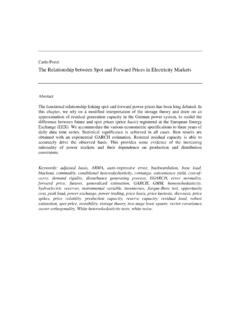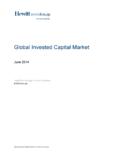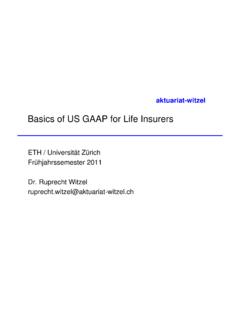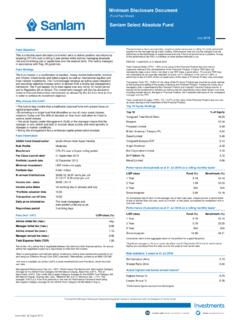Transcription of The Impact of Vertical Integration and Horizontal ...
1 1 Carlo PozziPhilippe VassilopoulosThe Impact of Vertical Integration and Horizontal Diversificationon the Value of Energy FirmsAbstractWe analyze the long-run return performance of 27 value-weighted equity portfoliosbased on a classification of the US energy sector that follows traditional industrialorganization categories. When adjusted to market and fuel risks, portfolio returns showthat both Vertical Integration and Horizontal diversification failed to produce shareholdervalue during the 1990-2003 period. This confirms the theoretical predictions of bothfinancial economics and industrial organization and shows that the wave of corporaterestructuring that has interested US energy industries over the last decade may haveoccurred at a net cost to firm.
2 Abnormalreturn,agency cost,agency theory, beta estimation,conglomerate, cumulated excess return, diversifiable risk, downstream, economy ofscale, economy of scope, excess return, Fama-French methodology, fitted return, fueldiversification,fuelrisk,Henry-Hub,h igh-minus-lowportfolio,horizontaldiversi fication, in-sample estimation, market beta, market portfolio, market risk,merger, midstream, multi-factor risk model, natural gas industry, oil industry, outliers,out-of-sample estimation, perquisite, portfolio diversification , power industry,production stage, pure player, return distribution, risk-adjusted return, risk-free rate,rolling regression, security market line, shareholder diversification , shareholder value,small-minus-big portfolio, standard industrial classification, synergy, systematic risk,takeover, theory of the firm, transaction cost, upstream, utility, utility regulation, valuechain, value-weighted equity portfolios, Vertical Integration , West-Texas theory posits both positive and negative impacts of Horizontal diversificationof firm value.
3 It also maintains that Vertical Integration produces value, when firmsinternalize functions which may not be adequately performed in the , there is large empirical evidence indicating that Horizontal diversificationacross multiple activities is generally harmful to stock value, while Vertical integrationhas at best mixed effects. For instance, Lang and Stulz (1993), Berger and Ofek (1995)and Servaes (1996) show the presence of a discount in the value of diversified firmswith respect to single business companies in various industries.
4 Likewise, in an era ofgrowing commoditization, the theoretical rationale of Vertical Integration is increasinglychallenged by the possibility of outsourcing various stages of firm value chains. Andboth facts seem to be significant throughout time and across this the case also in the energy sector? To answer this question, two separate aspectsshould be taken into account. The first has to do with the relative scarcity of industry-based literature on the value of fuel diversification and Vertical Integration in the energysector. Mainstream research seems to have little interest in the financial value of thesestrategies; hence some novel empirical analyses may be useful.
5 The second in the production of various fuels (for example, between oil andnatural gas in their extraction) or in the transformation of a primary source of energyinto a secondary source (as Hunt (2002) illustrates in the cogeneration of power andsteam). Therefore, it could be hypothesized that the energy sector enjoys some specialconditions, for which both Horizontal diversification and Vertical Integration possiblyhave inherent this chapter, we measure the financial value of these conducts by focusing on theequity return of a large sample of energy listings in the United States.
6 Using dailyportfolio returns, adjusted by systematic and fuel risks, we find scarce evidence tosupport the value-creating character of both phenomena. While our analysis shows somelimited value linked to Vertical Integration , there seems to be a significantdiversification discount across various US energy industries. This confirms previousempirical findings in other industries and seems to refute the specificities of the energybusiness. The claimed synergies stemming from Vertical and Horizontal expansions donot easily materialize and this may attest both to the inferior ability of firms, withrespect to equity markets, to allocate capital internally among various businesses and tothe negative effect of agency costs on equity value when firm executives engage invertical remainder of the chapter is organized as follows.
7 Section briefly summarizesthe existing empirical literature on Horizontal and Vertical expansion. Section the econometric methodology through which we determine the risk-adjustedperformance of energy equities. Section describes the dataset of equity returnsunder investigation. Section presents our results which, for clarity, are separatelydiscussed in distinct sub-sections. Finally, in Section , we draw some inferencesfrom the econometric findings which are presented in Section - Literature Vertical IntegrationIn his classic contribution, Coase (1937) sets the foundation of the theory of the and markets are alternative choices with respect to productionorganization, and transaction costs are the cornerstone.
8 Corporations vertically expanduntil the marginal cost of internalizing production equals the marginal cost ofoutsourcing it in the market. For instance, when buyers incur sunk costs to managerepeated transactions, they develop an incentive to (upward) internalize suppliers intotheir firm, so as to avoid potential losses linked to the latter s opportunism. Similarly,sellers are inclined to downward internalize distribution when exposed to potentiallosses because of high concentration among their leveraging on this general rationale, various authors have further discussed thefactual consistency of firm expansion.
9 Bain (1956, 1959) points out that verticalintegration, like the Integration of separate activities along a value chain, reflects thecreation of market power. Tirole (1988) sees it as a profitable response to the cost ofcontiguous monopolies (Tirole 1988). Others think it may facilitate price discrimination(Perry, 1978) or it can be used to raise rivals costs by increasing their costs of entry inthe industry (Aghion and Bolton 1987, Ordover, Salop and Saloner 1990, Hart andTirole 1990). Finally, Stigler (1951) advances a life-cycle theory arguing that, in aninfant industry, Vertical Integration is more likely because the demand for specializedinputs is too small to support their independent production.
10 In general, contractualincompleteness, combined with asset specificity, complexity and uncertainty, play acentral role in driving transaction costs and in the increase of the probability thatopportunistic behaviour may plague market relations (Carlton, 1979). So, as Joskow(1998a) points out, There is clearly no shortage of theories identifying potentialincentives for Vertical Integration . With this abundance of hypotheses, empirical studies have obviously thrived and haveattempted to assess the factual importance of various factors as principal drivers oftransaction costs.





